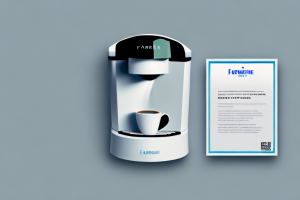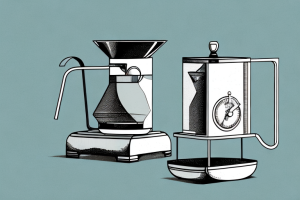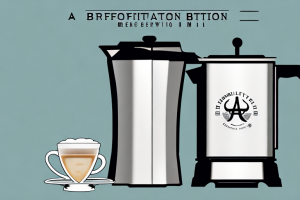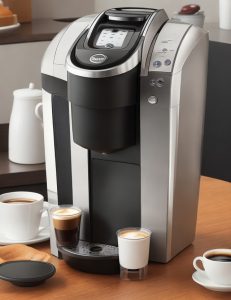Coffee Maker For Cappuccino
9 min read
A coffee maker with a cup of cappuccino next to it
If you’re a fan of cappuccinos, having a coffee maker that can create the perfect frothy milk is essential. But with so many options on the market, it can be overwhelming to choose the right one. In this article, we’ll cover everything you need to know to select the best coffee maker for cappuccinos, including the top models available, key features to look for, and how to master the art of crafting perfect cappuccinos at home.
Top 10 Coffee Makers for Cappuccino Lovers
Before we dive into the key features of a great coffee maker for cappuccino, let’s take a look at some of the top models on the market. The options below vary in terms of price, capacity, and features, so there’s something for everyone.
- Breville Barista Express
- De’Longhi Eletta Digital Super Automatic Espresso Machine
- Nespresso Vertuo Coffee and Espresso Maker
- Mueller Espresso Machine for Nespresso Compatible Capsule
- Keurig K-Cafe Single Serve Coffee Maker
- Mr. Coffee One-Touch CoffeeHouse Espresso Maker
- Saeco PicoBaristo Super Automatic Espresso Machine
- Capresso 125.05 Cafe Pro Espresso Maker
- Hamilton Beach Espresso Machine with Steamer – Cappuccino, Mocha, & Latte Maker
- Ninja Specialty Coffee Maker with Glass Carafe and Fold-Away Frother
When choosing a coffee maker for cappuccino, it’s important to consider the type of milk frother it has. Some models come with a steam wand, which requires a bit of practice to use effectively, while others have an automatic frother that makes the process much easier. Additionally, you’ll want to think about the size of the machine and how much counter space you have available. Some of the models on this list are quite large and may not be suitable for smaller kitchens.
How to Choose the Best Coffee Maker for Cappuccino
There are a lot of factors to consider when selecting a coffee maker for cappuccinos, but the following should be at the top of your list.
Size and Capacity
Consider how much counter space you have available and how many cups of cappuccino you want to make at once.
Milk Frother
The milk frother is arguably the most important part of a cappuccino maker, so be sure to choose one that can create rich, creamy foam.
Grinder
If you prefer to grind your own coffee beans, a built-in grinder is a must. But if you’re okay with pre-ground coffee, this feature may not be as important.
Programmable Settings
Some machines allow you to adjust the temperature, strength, and amount of water used, while others have preset options for convenience.
Cleaning and Maintenance
A cappuccino maker can get messy, so look for models that are easy to clean and maintain.
Price
Price is also an important factor to consider when choosing a coffee maker for cappuccinos. While some high-end models may offer more features, they may not fit within your budget. On the other hand, cheaper models may not have all the features you need. Consider your budget and what features are most important to you before making a purchase.
The Key Features to Look for When Selecting a Coffee Maker for Cappuccino
Let’s take a closer look at some of the key features we just mentioned.
Milk Frother
There are two main types of milk frothers: manual and automatic. Manual frothers require you to use a separate container and manually froth the milk using a pump or whisk. Automatic frothers, on the other hand, use a built-in mechanism to froth the milk for you. Some machines have both options, giving you more flexibility. Look for a frother that can create microfoam rather than big, airy bubbles. Microfoam gives you that velvety texture that makes a great cappuccino.
Grinder
If you choose a machine with a built-in grinder, look for one that offers a range of grind sizes so you can customize the strength of your coffee. A burr grinder will provide a more consistent grind than a blade grinder.
Programmable Settings
Some machines allow you to adjust the temperature, strength, and amount of water used, while others have preset options for convenience. If you like to experiment with different brewing styles and flavors, look for a machine with customizable settings.
Cleaning and Maintenance
Frequent cleaning is essential for preventing clogs and keeping your machine working properly. Some machines have automatic cleaning cycles, while others require manual cleaning. Look for a machine with removable parts that are dishwasher safe.
Water Reservoir
The size of the water reservoir is an important factor to consider when selecting a coffee maker for cappuccino. If you plan on making multiple cups of coffee at once, look for a machine with a larger water reservoir. However, keep in mind that a larger reservoir may take up more counter space. Additionally, consider the ease of refilling the reservoir. Some machines have a removable reservoir that can be easily refilled, while others require you to pour water directly into the machine.
Brewing Time
The brewing time of a coffee maker can vary depending on the machine. If you’re in a rush in the morning, look for a machine with a shorter brewing time. However, keep in mind that a shorter brewing time may affect the quality of the coffee. Some machines have a preheating feature that can reduce the brewing time without sacrificing the quality of the coffee.
How Much Should You Spend on a Coffee Maker for Cappuccino?
Coffee makers for cappuccino can range in price from less than $100 to upwards of $1,000. The price you should pay depends on your budget and how much you’re willing to invest in a high-quality machine. Generally, the more expensive models offer more features and a higher level of customization. However, there are plenty of affordable options that can still produce great cappuccinos.
The Pros and Cons of Automatic vs Manual Coffee Makers for Cappuccino
Both automatic and manual coffee makers have their pros and cons. Here are a few key differences to consider.
Automatic
- Convenient and easy to use
- May not produce the same quality foam as a manual method
- Can be more expensive
- Usually have more advanced features
Manual
- More affordable
- A more hands-on approach can be fun and satisfying
- Requires a separate container and additional steps
- Might be more challenging to create consistent results
A Beginner’s Guide to Making Perfect Cappuccinos with Your Coffee Maker
Making perfect cappuccinos requires practice and patience, but the following tips can help you get started.
Choose the Right Milk
Whole milk is the best choice for creating creamy, rich foam. Non-dairy options like almond milk and soy milk may not produce the same level of foam.
Froth the Milk Correctly
Swirl the milk before frothing to create a uniform texture. An automatic frother can take care of the rest, but for a manual frother, use a whisk or pump to froth the milk until it has achieved the appropriate level of foam.
Brew the Espresso Correctly
Brew a shot of espresso (about 1-2 ounces) and pour it into the bottom of the cup. This forms the base of the cappuccino.
Add the Frothy Milk
Pour the frothed milk over the espresso to fill the cup, holding back the foam with a spoon so that it can be added later.
Add the Foam
Spoon the foam on top of the milk until the cup is filled. The foam should be velvety and smooth rather than big and bubbly.
Tips and Tricks to Clean and Maintain Your Coffee Maker for Cappuccino
Keeping your cappuccino maker clean is important for ensuring it works properly and produces great coffee. Here are a few tips for keeping your machine in top condition.
Clean All Parts Regularly
Make sure to clean all parts of your machine regularly, including the frothing wand and any removable parts. Use a specialized cleaning solution or soap and water to remove any build-up.
Descale Your Machine
If you notice that your machine is not working as well as it used to, it may be time to descale it. This involves running a solution through the machine to break down mineral build-up and restore functionality.
Store Your Machine Properly
Store your cappuccino maker in a cool, dry place when not in use to prevent dust and moisture from building up.
Understanding the Different Types of Milk Frothers for Your Coffee Maker
As we mentioned earlier, there are two main types of milk frothers: automatic and manual. Let’s take a closer look at these types and what makes them different.
Automatic
Automatic milk frothers are built into the cappuccino maker and use an internal mechanism to froth the milk. Some machines have a separate container for the milk, while others froth the milk directly in the cup. Automatic frothers are generally more convenient and produce consistent results.
Manual
Manual milk frothers require you to use a separate container and manually froth the milk using a pump or whisk. This method can be more affordable and allows for more control over the process, but it can also be more time-consuming and may not produce the same level of foam as an automatic system.
Comparing Espresso Machines with Built-in Milk Frothers to Standalone Milk Frothers
Some espresso machines come with built-in milk frothers, while others require a standalone frothing machine or wand. Here are a few key differences to consider.
Built-In Milk Frothers
- Convenient and easy to use
- May be more expensive
- May not produce consistent results
Standalone Milk Frothers
- More affordable
- Allow for more control over the frothing process
- Require a separate appliance and can take up more counter space
How Technology Has Changed the Game of Making Cappuccinos at Home
In recent years, advances in technology have made it easier and more convenient to make great cappuccinos at home. Some coffee makers now come with built-in Wi-Fi or Bluetooth connectivity, allowing you to control the machine from your phone or tablet. Other features like automatic cleaning cycles and the ability to store multiple user profiles make it easier than ever to create the perfect cappuccino with minimal effort.
Best Practices to Follow While Brewing a Cappuccino with Your Coffee Maker
Here are a few final tips to keep in mind as you perfect your cappuccino-making skills.
Use Fresh Coffee Beans
Fresh, high-quality coffee beans will produce a better-tasting cappuccino than stale or low-quality beans.
Preheat Your Mug
Heating up your mug before you add the espresso and frothed milk can help keep your drink at the optimal temperature for longer.
Practice Makes Perfect
Brewing perfect cappuccinos takes practice and experimentation. Don’t be afraid to try new techniques and recipes to find what works best for you.
Troubleshooting Common Issues with Your Coffee Maker When Making a Perfect Cappuccino
Even with the best coffee maker and the freshest ingredients, issues can still arise when making a cappuccino. Here are a few common problems and how to resolve them.
Weak or Watery Milk Foam
If your milk foam is weak or watery, try using a higher-fat milk or frothing the milk for a longer period of time.
Bitter or Sour Espresso
If your espresso tastes bitter or sour, try adjusting the grind size, brewing temperature, or brew time until you find the right combination.
Clogs or Leaks
If your machine is clogging or leaking, check for any blockages or faulty parts. Unclogging the machine or replacing the parts should resolve the issue.
Does the Grinder in Your Coffee Maker Affect the Taste of Your Cappuccino?
The grinder in your coffee maker can have a significant impact on the flavor and strength of your cappuccino. A burr grinder will produce a more consistent grind, which can lead to a better-tasting cup of coffee. A blade grinder, on the other hand, can produce an uneven grind, which may result in a weaker or more bitter cappuccino.
Unique Recipes to Try Out with Your New Coffee Maker for Cappuccino
Once you’ve mastered the art of making a classic cappuccino, try experimenting with different flavors and ingredients to create unique, customized drinks. Here are a few ideas to get you started:
- Caramel Macchiato Cappuccino – Add a shot of caramel syrup to your espresso, then pour frothed milk and foam on top.
- Peppermint Mocha Cappuccino – Add a shot of peppermint syrup to your espresso and top with frothed milk and whipped cream.
- Vanilla Bean Cappuccino – Add a bit of vanilla bean paste to your frothed milk for a subtle but delicious flavor.
The Bottom Line
As you can see, there’s a lot to consider when selecting a coffee maker for cappuccinos. Whether you prefer an automatic or manual frother, a built-in grinder, or customizable settings, there are options available to fit your needs and budget. With a little practice and patience, you can master the art of creating perfect cappuccinos at home.



